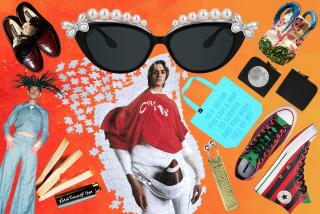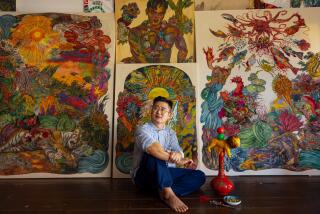Wu Tsang at Michael Benevento Gallery
“Mishima in Mexico” (2012), the standout in the debut L.A. solo exhibition of recent work by Wu Tsang, is a cross-cultural, cross-dressing, operatic telenovela imbued with the stylized elegance of Kabuki theater. The video, which was included in the Museum of Contemporary Art’s fall exhibition “Blues for Smoke,” is a 14-minute effort to create art and identity within today’s swirling sociocultural hall of mirrors.
It succeeds by understanding and conveying two things. First, art and identity are both questions, not answers. And second, those questions need to be visually and conceptually seductive.
At Michael Benevento, the video is projected in a small white room whose ceiling lights are programmed to shift among blue, pink, yellow and crimson. The colors change to underscore points in the melodramatic narrative, while adding a witty nightclub ambience to a standard white-cube gallery. Tsang has a gift for stirring the pot.
PHOTOS: Arts and culture in pictures by The Times
The stirring begins straightaway. “Mishima in Mexico” opens on the turbulent fountain of churning water at the stylish entry to the landmark Camino Real Hotel in Mexico City. Tsang and his writer, Alexandro Segade, check into a room, which injects the aura of an illicit afternoon tryst into the ensuing story of erotic obsession.
Inspired by Yukio Mishima’s 1950 novel “Thirst for Love,” the artists struggle to plot the video that we’re looking at, cutting back and forth between scenes of the fictional narrative and the story of writing and recording it. Various cultural cliches get injected (and rejected) along the way. Cravings cut many ways.
The show also includes Tsang’s short 2012 video “Tied and True,” co-directed by Ghanaian filmmaker Nana Oforiatta-Ayim and inspired by Douglas Sirk’s 1955 melodrama “All That Heaven Allows,” whose story is an American cousin to “Thirst for Love.” A separate installation of photographs and text sets two rows of pictures on opposite walls; a suspended theatrical light-rigging and a painted shadow on the floor are between them.
One row of photos is accompanied by descriptive text, the other row seems to have absorbed that text into the printed photographs. The technique doesn’t quite work, partly because the images are dull. But Tsang is wrestling with visual and literary narrative, and he’s doing it in ways that bear watching.
Michael Benevento Gallery, 7578 & 7556 Sunset Blvd., Hollywood, (323) 874-6400, through July 7. Closed Sun. and Mon. www.beneventolosangeles.com
More to Read
The biggest entertainment stories
Get our big stories about Hollywood, film, television, music, arts, culture and more right in your inbox as soon as they publish.
You may occasionally receive promotional content from the Los Angeles Times.







